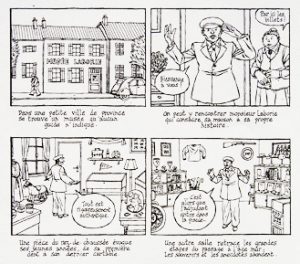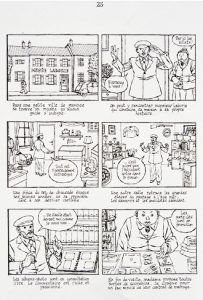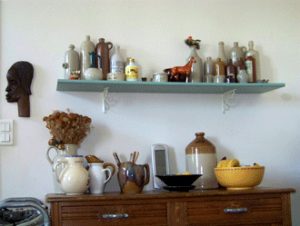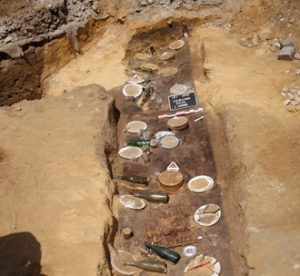
Thierry Bonnot exits from the strictly positivist view the social sciences hold of objects. No, he says — in the wake of other researchers who have refreshed the history of things — objects are not “witnesses” but social facts that have complex relationships with human beings as they interact in our social exchanges. In his latest work, L’attachement aux choses (2014), Bonnot mentions Daniel Miller and Fiona Parrot’s very interesting investigation of the inhabitants of London. These investigators’ conclusions run counter to received ideas: No, consumerism has not killed our attachment to things; the closer our relationships with objects, the closer, too, our relationships with other persons.
Objects: Beetween Art and Social Sciences
An Interdisciplinary Essay Accompanied by some Anthropological Reflections
Thierry Bonnot
My work on objects has led me to reflect on the heuristic connections between art and anthropology, history and archeology, centered on the study of material objects. I will rely here on three art works I have used in my latest book1 in order to blur still further the boundaries between the methods and objects of various disciplines and to show in what way art can assist the social sciences by posing good questions.
The Laborie Museum

The Laborie Museum, by François Ayrole, Editions l’Association.
A François Ayroles comic, which appeared in 2000, recounts the visit to a French provincial museum a man has devoted to his own life. Let us consider this fictive situation as a parable, while at the same time taking it seriously, for, by analogy, this tiny museum of the individual refer us back to certain field experiments.
The occupants of a house tell their life story through their home and the objects with which they have filled it. Here, the social logic of such an enterprise is pushed to the extreme of the incongruously comical. Numerous sociologists have taken an interest in such “self-staging.”2 Rather than staging himself in an implicit manner, Monsieur Laborie has chosen to do so explicitly, by opening his space to a broad public. What makes this home a museum is not the nature of the objects exhibited but the way in which they are laid out in space; the performance undertaken by Monsieur and Madame Laborie, who play the role of guide and hostess; and the inscription “Laborie Museum” on the building’s facade, which sets the social framework for the action.
The principal value of the museum’s objects stems from their being attached to Monsieur Laborie: they belong to him; he has used them, worn them out, loved them and then abandoned them without getting rid of them. “Everything,” he says, “is strictly authentic.” What serves to authenticate the objects is that they belong to Laborie and have shared the various stages of his existence. He has selected them as significant objects that have marked the “major stages” of his life, such as his first tooth, his last school bag, his stuffed bear, his communion gown, and so on. The items have been selected according to emotional criteria, but also with the concern that these objects might remind the museum-going public of their own existence. The notion of a museum implies at least some correspondence with collective representations, whether in the realm of art, history, or society. In Monsieur Laborie’s effort, there is a genuine intellectual approach. He clearly has a set idea of “what is” or “what should be” a museum object, that is to say, an object that is at least remotely representative (of an era, of a region, of a typical existence).
At first sight, the contents of the Laborie Museum have only an individual pertinence. Its objects have value only for him, and perhaps too for his spouse. His museum is devoted to the life of an unknown person, of an “everyman” who has apparently accomplished nothing of note, except to have ordinarily lived an ordinary existence. That is what makes him unintentionally comic. But it is precisely this ordinariness that broadens the circle of individuals for whom these objects have some interest. This museum will thus play the metaphorical mirror role Georges-Henri Rivière attributed to ecomuseums created and hosted by a specific population: “A mirror in which this population looks at itself in order to recognize itself therein, in which it seeks to analyze and explain the land to which it is attached. . . A mirror that this population holds out to those it receives, in order to make itself better understood, in accordance with its labor, its behaviors, its private life.”3
The reflection of the mirror in which Laborie gazes at himself and which he holds up to his visitors will be evocative for those who have shared, even remotely, the same ordinary experiences as their host, and it will be evocative, too, for the foreign tourists who find therein a whiff of exoticism. Thus, however comical and absurd as it may be, the story of the Laborie Museum proves to be pertinent to a reflection on museum discourse.
An Anecdoted Topography of Chance

Topography of my kitchen; photo by Thierry Bonnot.
In 1961, on October 17 at 3:47PM, Daniel Spoerri set on paper a topographical relief map of the objects present on a table in his room at the Carcassonne Hotel on the rue Mouffetard in Paris. Each number, from 1 (“slice of white bread with a bite out of it . . . ”) to 80 (“cigarette burn on the first carbon copy of the present topography”), corresponds to a more or less long note made up of basic descriptions (“2. Very light pale green plastic egg cup on three small legs . . . ”), personal recollections connected to the object, literary quotations, and dialogues sometimes placed in footnotes.
Spoerri presented his project as follows: “I wanted to see what the objects that were found on half of this table, and from which I could have done a snare-picture,4 might suggest to me, and what they would immediately arouse in me while describing them—like Sherlock Holmes who, starting from an object, could solve a crime, or like historians who, for centuries, have been reconstructing an entire era on the basis of the most famous fixation of history, Pompeii.”5
According to Roland Topor, in his Preface to the 1990 French edition, the random character of this type of description is a condition for its success, “objective reality arranged by chance ultimately being the surest way of obtaining an image that resembles our life.”6
What, on the basis of the most scrupulous description possible of a set of objects, are the ways in which one might offer “an image resembling the life” of the proprietor of the place in question? Might the social sciences be able to draw from this description and from this singular life some bits of relevant knowledge? Do the objects that are here, all around us, by chance or by necessity teach us something about social life?
In Spoerri’s experiment, the notion of “chance” appears interesting and recourse to self-analysis here proves useful. Can an object be found by chance in my kitchen? Is a pen or a notepad found by chance on my desk? The objects situated on the artist’s table, in October 1961, did not arrive there independent of any human intention, nor did they arrive there outside of any contextual influence connected to the place, the times, the lifestyle, and the artistic activity of their owner. Ultimately, the exercise in which Spoerri engaged relates to chance only on the scale of the object’s localization in the limited space of his lodging, nay of the table itself: it may be by chance that such and such an object is to be found in this place in the hotel room or in that precise spot on the table. But what does not pertain to chance is that this bowl, this glass jar, this glue jar are to be found in Spoerri’s hotel room. They are there because the artist had need of them or a desire for them at a given moment in his existence, or because someone offered them to him or forgot them here, and above all because the occupant of the premises conserved them. The artist’s objective was to produce a photograph—in the figurative sense—of a moment, of an arrangement resulting, according to him, from some chance. The anthropological or archeological approach to this same situation would consist in describing in the subtlest and most complete way possible not only the objects and the people or circumstances they evoke but also the historical, social, and political conditions for their journey to that spot. The objects are never there by chance. It is the role of the social sciences to work on what brought them here, on their route, which is dependent on human intentions and actions.
Luncheon Under the Grass

Excavations for Luncheon Under the Grass; Photo by B. Müller.
On April 23, 1983, Spoerri organized a banquet at Jouy-en-Josas to which art critics, artists, art dealers, and other socialite personalities were invited. Before the meal was over, the trays on the trestles that served as tables for the guests were deposited at the bottom of a long trench that had been dug prior to the meal. The whole setup was then filled back in with a view toward an archeological dig that would not take place until 27 years later. It was an initiative on the part of the anthropologist Bernard Müller, in cooperation with Spoerri and with the scientific support of the archeologist Jean-Paul Demoule, that made it possible to carry out this project in 2010. The dig was conducted under the auspices of the French National Institute of Preventive Archeological Research (INRAP), which scrupulously observed the criteria of modern archeological methods.
What bits of reflection can we draw from this performance? First of all, it has allowed one to assess how fallible memory is: testimony from participants diverged as to the location of the trench, the presence of this or that person, and of this or that object (plastic cups, for example).
Second, this kind of experiment makes us feel modest about our analyses and our willingness to interpret the presence of things. Let us hypothesize about an accidental discovery of this luncheon: Who could have imagined that an artistic performance had taken place there? This issue of how to interpret the “data” is bothersome for archeology but also for the social sciences. Archeologists are always defending against the Pompeii syndrome (“the creations of the past are buried intact, beneath the accumulation of a series of subsequent, sterile strata it would suffice to remove in order to restore their hidden integrity”).7 Some experiments, like that of “Millie’s camp,” have summoned this discipline to act more humbly.8 Archeological data are here, with us, in the present, as an integral part of our environment and of our social life; they have an impact on the contemporary world. Archeology is above all a destructive operation. Archeological discoveries do not yield us the past, intact. We construct that past; it rises up again in the light of the present. Anthropologists might profitably aspire to a like modesty when they interpret the relationships between men and objects. The site also highlights the connections between art, archeology, and anthropology. What remains up in the air is the question of the status of the works and who owns them. Are they art objects? Archeological objects? Objects of interest to anthropology, as a social-scientific study of the mores of the 1980s art world in France? We are not finished meditating on such experiments, which lie at the crossroads of art, archeology, and anthropology.
All I have treated here pertains to play [jeu], under several headings. There is the comic book artist who uses his drawing to play on the idea of a museum, the artist Spoerri playing with everyday objects, archeologists and anthropologists playing around with Spoerri’s idea. We can see therein also a game [jeu] in the technical sense of the term: there is a play among disciplines as between two out-of-sync cogs in a machine. There is the spatial and dynamic play, in the social sciences, around objects. For, the latter are not simply scientific data to be collected: they are agents of social life and they can be made to “play a game” that goes beyond the simple role of being elements in a decor. The play of objects’ successive attachments generates their becoming, the biography of which allows us to bring out tensions, failures, and accidents that challenge the uniform linearity of following a single path. The becoming of an object is not a succession of clear-cut statuses; it can experience phases in which there are confusions of status, superimpositions, and bifurcations. The biographical method, as applied to objects, consists in producing narratives that allow one to describe a succession of social situations and a multiplicity of social relations among individuals, collectives, and objects. Working on objects obliges us to be more humble, for ultimately they always escape our grasp, even when we think we have a hold on them. That is why investigations into objects should not be perceived as more solidly positivistic than investigations into other, less tangible themes. We are also prey to doubt and subject to the fragility of what we assert.
1 Thierry Bonnot, L’attachement aux choses (Paris: CNRS Éditions, 2014).
2 Daniel Miller, ed., Home Possessions: Material Culture Behind Closed Doors (Oxford and New-York: Berg 2001); Martine Segalen and Beatrix Le Wita, eds, Chez-soi. Objets et décors: des créations familiales? (Paris: Autrement, 1993).
3 Georges-Henri Rivière, “Définition évolutive de l’écomusée,” Museum, vol. 37, no. 148 (1985): 182-183 (quotation from p. 182).
4 Snare-pictures are Spoerri’s best-known works. Objects are glued onto a board that becomes a picture when it is exhibited vertically on a wall; the best-known snare-pictures are made up of dishes, place settings, and reliefs of meals glued on a table.
5 Daniel Spoerri, Topographie anecdotée du hasard, preface by Roland Topor (Paris: Éditions du Centre Pompidou, 1990 [1962]), quotation from p. 5.
6 Roland Topor, “Préface à la réédition du 1990,” in Daniel Spoerri, ibid., p. 2.
7 Laurent Olivier, Le sombre abîme du temps (Paris: Éditions du Seuil, 2008), p. 74.
8 Ibid., p. 53-56.
APPADURAI, Arjun. Ed. The Social Life of Things: Commodities in Cultural Perspective. Cambridge, England: Cambridge University Press, 1986.
AYROLES, François. Notes mésopotamiennes. Paris: L’association, 2000.
BAZIN, Jean. Des clous dans la Joconde. Toulouse: Anacharsis, 2008.
BONNOT, Thierry. La vie des objets. Paris: Éditions de la Maison des Sciences de l’Homme/Mission du Patrimoine Ethnologique, 2002.
BONNOT, Thierry. L’attachement aux choses. Paris: CNRS Éditions, 2014.
SEGALEN, Martine, and Beatrix LE WITA. Eds. Chez-soi. Objets et décors: des créations familiales? Paris: Autrement, 1993.
DEMOULE, Jean-Paul. “Archéologie, art contemporain et recyclage des déchets.” Techniques et culture, 58 (2012): 160-77.
HAINARD, Jacques and Roland KAEHR. Eds. Objets prétextes, objets manipulés. Neuchâtel: Musée d’Ethnographie, 1984.
HEINICH, Nathalie. “Les objets-personnes: fétiches, reliques et œuvres d’art.” Sociologie de l’art, 6 (1993): 25-55.
MILLER, Daniel. Ed. Home Possessions: Material Culture Behind Closed Doors. Oxford and New York: Berg, 2001.
RIVIÈRE, Georges-Henri. “Définition évolutive de l’écomusée.” Museum, vol. 37, no. 148 (1985): 182-83.
SPOERRI, Daniel. Topographie anecdotée du hasard. 1962. Preface by Roland Topor: Paris: Éditions du Centre Pompidou,1990.
